Jyoti Sondagar | Designer, Researcher, Strategist based in New York
ux research & testing | interaction design | product design
B2B Furniture Distribution & Data Management Platform
Role
Designer, Researcher, Strategist
Duration
15 Weeks
client
Hopdesk
SKILLS
Product Design, Interactive prototype, User research & testing, Business Model Canvas, Budget Allotment, Ideation Workshops
collaborators
Business Strategist
UI Developers
CEO & CFO
Stakeholders
the challenge
How might we design a seamless system for Hopdesk to manage and track furniture assets, creating a more efficient and reliable service?
Hopdesk acts as a vital bridge between employers and their remote employees, offering a unique chance to transform not just logistics but the entire remote work experience. By reimagining how distributed teams are managed, we aim to create a seamless, integrated platform that empowers users with greater efficiency, transparency, and control.
The rise of hybrid work has led to a surge of “micro-offices,” posing a major challenge for traditional workplace management. Existing systems struggle to handle the complexities of furniture distribution and logistics for a geographically dispersed workforce.
As Hopdesk grows its customer base, it needs a more robust platform to support a number of furniture distribution and logistical challenges.
the strategy
Bridging logistical gaps and driving innovation with a user-friendly platform for streamlined furniture ordering and logistic management.
We developed a digital platform strategy to streamline Hopdesk’s engagement with: Hopdesk Admin, client CFOs/COOs, employees.
- Key Features
Hopdesk Admin – An internal platform for managing client orders, logistics, support tickets, and delivery tracking.
Client (CFO & COO View) – A platform for finance and operations leaders to manage and track employee orders of furniture.
Employee Interface – A user platform for placing furniture orders, tracking deliveries, managing payments, and accessing support.
- Project Goal
Design and build a MVP that streamlines procurement, tracking, and maintenance-without disrupting the experience for existing clients.
overview
What we learned ?
The existing asset management process is time consuming, and rudimentary.
We interviewed 20+ participants – including operations managers, facility managers, and team members to uncover bottlenecks, understand workflows, and identify key challenges. We found that the current asset management system is time-consuming and prone to errors, leading to delivery delays and strained client relationships.
Major Issues
- Manual, time-consuming workflows
Reliance on manual data entry, spreadsheets, and inconsistent communication led to delays, errors, and duplicated work.
- Limited Visibility Across Distributed Assets
Stakeholders lacked real-time insight into asset location, usage, and condition, making it difficult to track and manage remote office inventory effectively.
- Gaps in stakeholder collaboration
No structured way to monitor asset depreciation, replacement needs, or reuse potential, leading to financial inefficiency.
Pain-points within the current journey
Key Steps
Understand
Plan
Request
Prepare
Order
Track
Submit
Follow-up
Manage

Hopdesk
Receive Request
- Receiving scattered, inconsistent requests from multiple companies.
- Lacking a unified platform for communication
Deliver & Install
- Manually handling delivery, returns, and replacements.
- Limited visibility into the overall asset lifecycle.
Manage Lifecycle
- No streamlined process for returns or replacements
- Difficulty in managing asset depreciation and reallocation.

Stakeholder
Request & Plan
- Need to provide home-office setups for remote employees.
- Manually tracking orders, deliveries, and returns.
Order & Track
- Using excel/emails to track orders, leads to duplication and delays.
- Lack of real-time visibility into asset status or condition.
Follow-up & Manage
- Difficulty in managing asset lifecycle (reallocation, etc.).
- Limited visibility into equipment usage and condition.

Employee
Need & Request
- Request furniture/equipment for remote setup by manual process
- Wait for approvals and deliveries
Await Delivery
- No source of truth for where assets are.
- Creates miscommunication with managers and HR.
Use & Manage
- Managing damaged or outdated items is a cumbersome process.
- Delays or a lack of ergonomic equipment reduce satisfaction.
Pain-points
Poor Coordination Between Stakeholders
- Vendors, HR, and employees operate in silos.
- Approval processes are slow and often involve back-and-forth emails.
Employee Experience Impact
- Delays or lack of ergonomic equipment reduce satisfaction and productivity.
- Remote employees often feel unsupported.
Decentralized & Manual Tracking
- Employers rely on spreadsheets/emails to track furniture orders, delivery, and returns leads to duplication, delays, and higher costs.
Lack of Real-time Visibility
- Employees and managers have no single source of assets tracking rather then email/call, this condition creates frustration and miscommunication.
Difficulty in Managing Asset Lifecycle
- Depreciation, replacement, and reallocation are not streamlined.
- Old or damaged items pile up, impacting efficiency and sustainability.
Lack of Real-time Visibility
- Employees and managers have no single source of assets tracking rather then email/call, this condition creates frustration and miscommunication.
Pain-points within the current journey
Key Steps
Understand
Plan
Request

Hopdesk
Receive Request
- Receiving scattered, inconsistent requests from multiple companies.
- Lacking a unified platform for communication

Stakeholder
Request & Plan
- Need to provide home-office setups for remote employees.
- Manually tracking orders, deliveries, and returns.

Employee
Need & Request
- Request furniture/equipment for remote setup by manual process
- Wait for approvals and deliveries
Pain-points
Poor Coordination Between Stakeholders
- Vendors, HR, and employees operate in silos.
- Approval processes are slow and often involve back-and-forth emails.
Employee Experience Impact
- Delays or lack of ergonomic equipment reduce satisfaction and productivity.
- Remote employees often feel unsupported.
Key Steps
Prepare
Order
Track

Hopdesk
Deliver & Install
- Manually handling delivery, returns, and replacements.
- Limited visibility into the overall asset lifecycle.

Stakeholder
Order & Track
- Using excel/emails to track orders, leads to duplication and delays.
- Lack of real-time visibility into asset status or condition.

Employee
Await Delivery
- No source of truth for where assets are.
- Creates miscommunication with managers and HR.
Pain-points
Decentralized & Manual Tracking
- Employers rely on spreadsheets/emails to track furniture orders, delivery, and returns leads to duplication, delays, and higher costs.
Lack of Real-time Visibility
- Employees and managers have no single source of assets tracking rather then email/call, this condition creates frustration and miscommunication.
Key Steps
Submit
Follow-up
Manage

Hopdesk
Manage Lifecycle
- No streamlined process for returns or replacements
- Difficulty in managing asset depreciation and reallocation.

Stakeholder
Follow-up & Manage
- Difficulty in managing asset lifecycle (reallocation, etc.).
- Limited visibility into equipment usage and condition.

Employee
Use & Manage
- Managing damaged or outdated items is a cumbersome process.
- Delays or a lack of ergonomic equipment reduce satisfaction.
Pain-points
Difficulty in Managing Asset Lifecycle
- Depreciation, replacement, and reallocation are not streamlined.
- Old or damaged items pile up, impacting efficiency and sustainability.
Lack of Real-time Visibility
- Employees and managers have no single source of assets tracking rather then email/call, this condition creates frustration and miscommunication.
Process
Who are the users?
Platform has 3 types Our primary users included Hopdesk Admins, client CFOs/COOs, and employees, each with different service goals, and management with the levels of literacy.
I want A centralized system to manage orders, service requests, inventory status, usage trends, and budgets.

Jemison
Hopdesk
Hopdesk manages end-to-end furniture distribution, from orders to delivery, ongoing services on a daily basis, ensures timely order fulfillment, and updates stakeholders with real-time data.
I want a one-click solution to manage orders, tracking, financial reporting, and handling issues like repair, and broken items.

Clara
CFO/COO
The CFO/COO ensures employees receive the right WFH furniture by managing budgets, approving expenses, tracking asset requests, and aligning reporting and receipts with the finance team.
I want an easy-to-use service with a searchable catalog, faster approvals, and clear guidance for ordering, repairs, and replacements without the usual delays.

Tom
Employee
Employees must request WFH assets through multiple approvals (manager, facilities, finance). Submitting receipts is cumbersome, and returns or replacements are frustrating and slow.
High
Low
Service & Managing Literacy
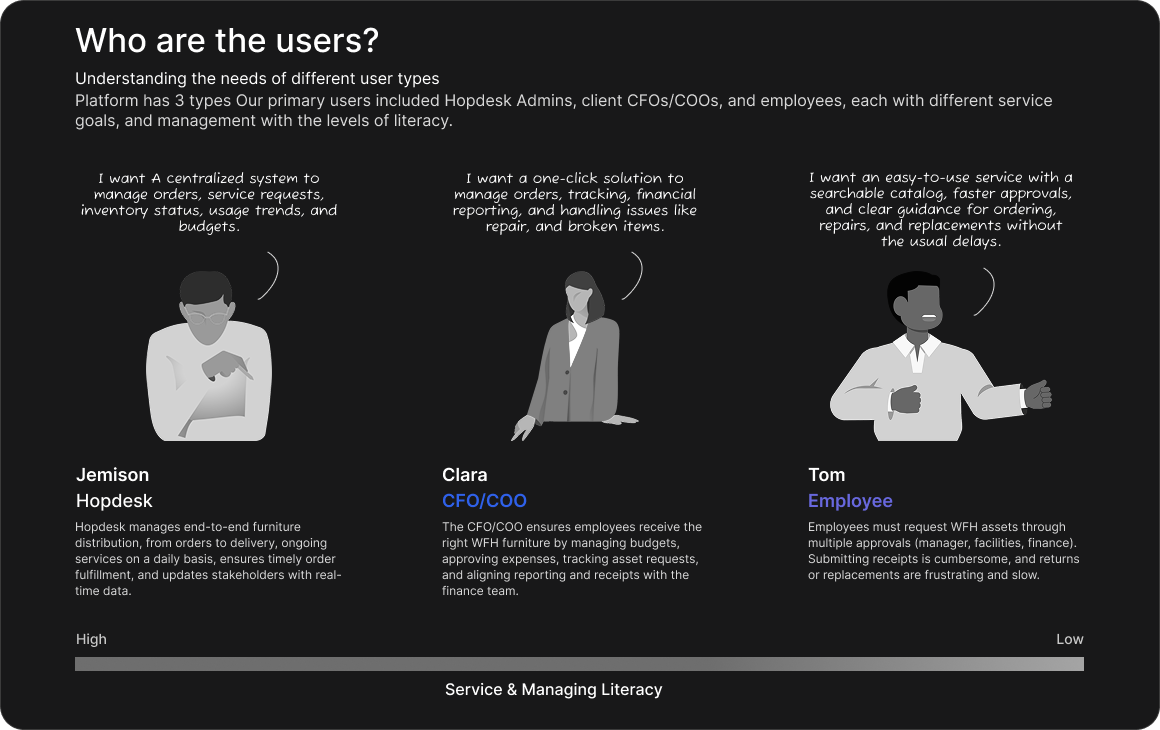

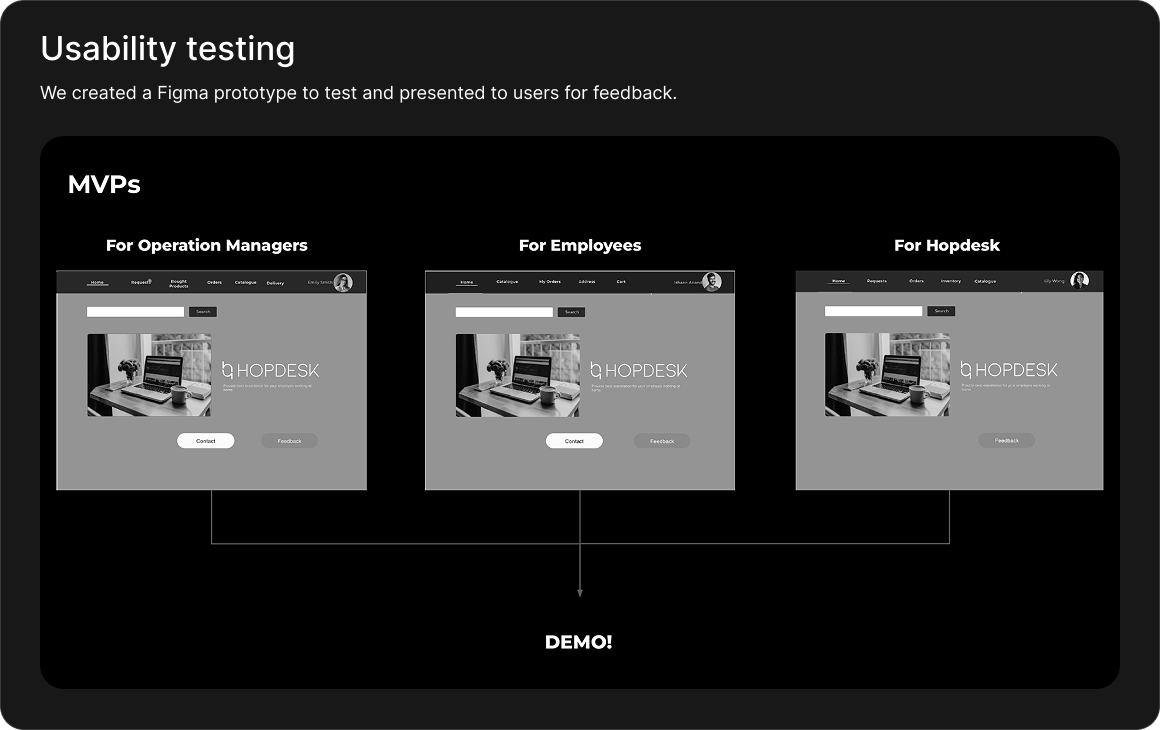
Design
Final Design

As the CEO of Hopdesk, I want A centralized platform to oversee orders, service requests,
inventory status, usage trends, and budget management.
With all operational workflows
With the centralizes all operational workflows, giving admins complete visibility and control: Manage requests, track inventory, coordinate logistics & tickets, and generate reports for data on orders, usage, and inventory

reporting, and address issues such as repairs, and damaged items seamlessly.
With financial and operational aspects of asset management
An integrated dashboard with track budgets, approve requests, delivery updates, audit asset records, and generate reports.

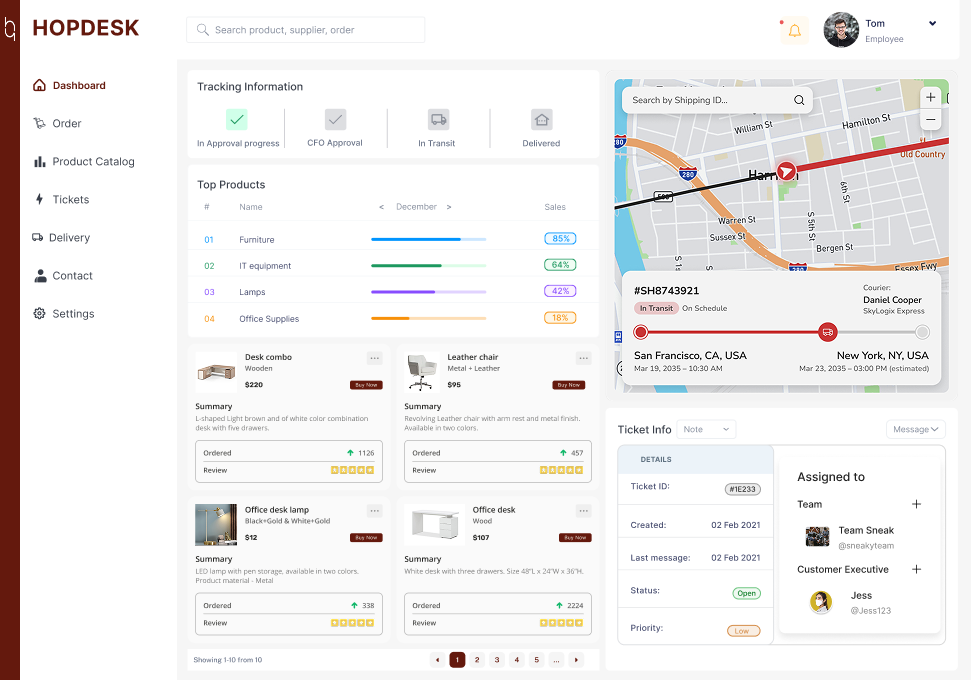
With the order & ticket tracking
Employees have the option to browse and select necessary assets from the catalog, arranging for them to be delivered to their designated address. Users can conveniently monitor the delivery progress, make changes to selected items, and request repair or replacement services as needed.
Impact
Within few months Hopdesk got these updates:
50%
Reduction in asset management time
An agile platform has a major
impact of asset handling, reducing
asset mismanagement, and errors
18%
Reduction in overhead costs
Achieved a massive impact to overhead costs by streamlining workflow and reducing manual intervention.
2X
Improved query resolution speed
Query resolution time was cut in half, highlighting improved system usability and overall performance.
understanding the challenge
This case study explores Hopdesk’s shift toward a scalable, centralized platform to meet the evolving needs of distributed enterprises.

understanding the context (b2b)

research

Define

ideation

wireframing
&
prototyping

user testing
&
evaluation
understanding the context
After the project start, we defined strategy and objectives, prioritizing an in-depth understanding of market (B2B), our target users and challenges.
- Understanding the Market & Target Audience
As hybrid work became the norm, Hopdesk faced increasing challenges managing remote office assets across multiple locations. A seemingly simple request to improve order and tracking functionality uncovered deeper issues – limited visibility, inadequate depreciation tracking, and fragmented workflows. Our primary users included Hopdesk Admins, client CFOs/COOs, and employees.


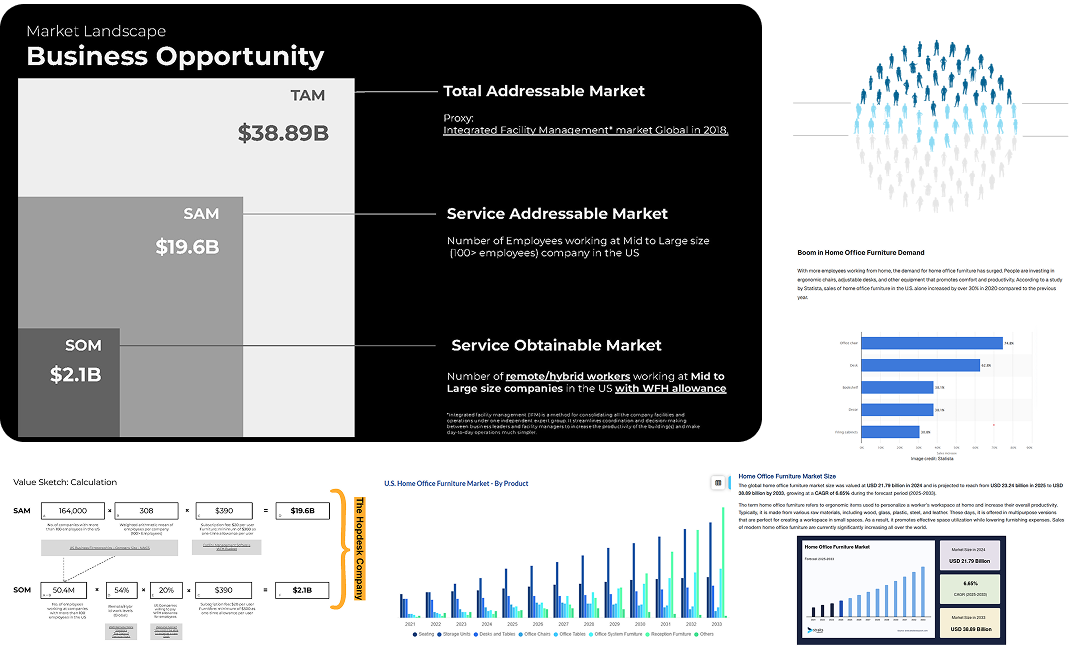
research
After the project start, we defined our research strategy and objectives, prioritizing an in-depth understanding of needs and challenges.
- Understanding the Problem
Our goal was to understand the aesthetic and operational needs of the process. The primary users are Hopdesk representatives who manage furniture sourcing and full inventory oversight for buyers.
Secondary Research
We started our process with desk research and competitive analysis to analyze the current market trend, features and information structure.
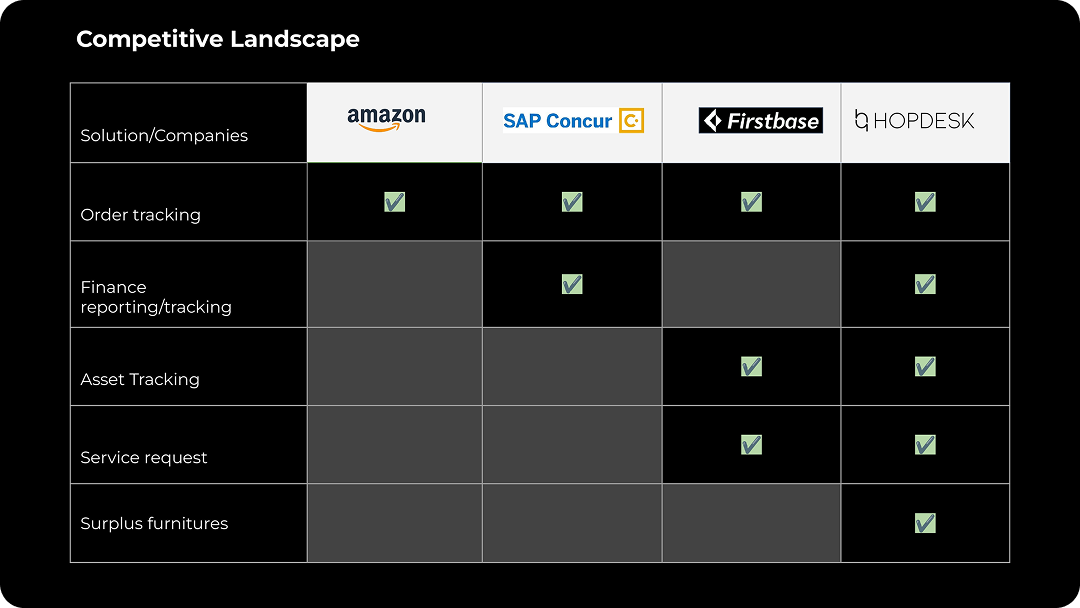
Secondary Research
We interviewed 20+ participants – including operations managers, facility managers, and team members to uncover bottlenecks, understand workflows, and identify key challenges.
Script


Notes on Opportunities

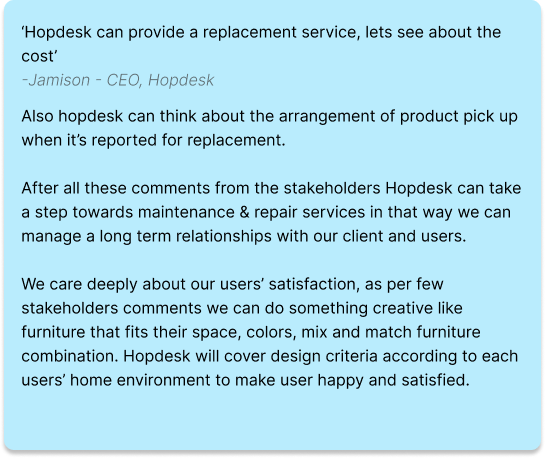
Define
Carving out a niche in a complex structure system
- Persona & Scenario
With the valuable responses from interviews and observations, I created a user persona that captures key behaviors, tools used, pain points, and needs.
Asset managing issues Contexts Personas
Scenario
persona
characte
ristics

Hopdesk

Jemison - 6+YOE
“As our business grows, it’s becoming harder to keep everything updated in real time. We’re tracking budgets, employee needs, performance, and even furniture quality-has become a real challenge across teams.”
Data is spread across Excel, emails, and chat tools-no single source of truth
Tracking item spend and depreciation is time-consuming and error-prone. Replacing or repairing items involves unclear, multi-step manual processes
I want A centralized platform to manage orders, service requests, inventory status, usage trends, and budgets.
commonality
All three users want a centralized, easy-to-use platform that simplifies ordering, tracking, reporting, and managing service requests - reducing delays and making the entire process more efficient and transparent.
*All attributes of the above personas were extracted from the interviews.
Asset managing issues Contexts Personas
Scenario
persona
characte
ristics

CFO/COO

Clara - 20+YOE
“It seems that we are going to stay in this hybrid model for the future. So we really need good frameworks and tools to track items in the micro offices. Right now it’s very manual. It’s a mess.”
No clear guidance on how to track items in the micro offices
Too many receipts – Reporting to the finance department takes too much time.
When employee quit – Help with end of use cases, Guidance on what items belong to whom
So, I want a one-click solution to manage orders, tracking, financial reporting, and handling issues like repair, and broken items.
commonality
All three users want a centralized, easy-to-use platform that simplifies ordering, tracking, reporting, and managing service requests - reducing delays and making the entire process more efficient and transparent.
*All attributes of the above personas were extracted from the interviews.
Asset managing issues Contexts Personas
Scenario
persona
characte
ristics

Hopdesk

Tom - 5+YOE
“If I want wants to have something that is not in the tool, I have to request it then I have to get an approval for it first from manager, then facility managers and finance.”
It’s a cumbersome process with a lot of steps
Ordering from other sites is a nightmare and has to wait too long for the approvals
Long wait to get an approval for replace or repair broken furniture
I want a one-click
I want an easy-to-use tool with a searchable catalog, faster approvals, and clear guidance for ordering, repairs, and replacements without the usual delays.
commonality
All three users want a centralized, easy-to-use platform that simplifies ordering, tracking, reporting, and managing service requests - reducing delays and making the entire process more efficient and transparent.
*All attributes of the above personas were extracted from the interviews.
3 Asset managing issues
Contexts
Personas
Scenario
persona
characteristics

Hopdesk

Jemison - 6+YOE
“As our business grows, it’s becoming harder to keep everything updated in real time. We’re tracking budgets, employee needs, performance, and even furniture quality-has become a real challenge across teams.”
Tracking item spend and depreciation is time-consuming and error-prone. Replacing or repairing items involves unclear, multi-step manual processes
I want A centralized platform to manage orders, service requests, inventory status, usage trends, and budgets.

CFO/COO

Clara - 20+YOE
“It seems that we are going to stay in this hybrid model for the future. So we really need good frameworks and tools to track items in the micro offices. Right now it’s very manual. It’s a mess.”
Too many receipts – Reporting to the finance department takes too much time.

Hopdesk

Tom - 5+YOE
Ordering from other sites is a nightmare and has to wait too long for the approvals
commonality
All three users want a centralized, easy-to-use platform that simplifies ordering, tracking, reporting, and managing service requests - reducing delays and making the entire process more efficient and transparent.
*All attributes of the above personas were extracted from the interviews.
- Insights
After analysis of secondary research and user interviews, participants’ responses were synthesized to identify key themes, opportunities, and potential features.

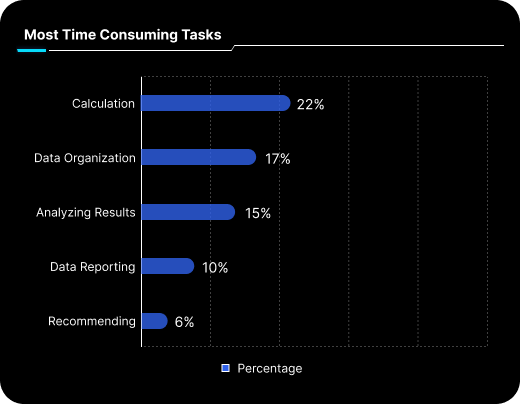
Users mainly use MS Excel spreadsheets to enter the data.
Users want to see the results in a concise and visual formate which is easy to understand.
Managers want to quickly find and organize relevant data and tickets from employees.
Due to the complexity of calculations they often delayed & deliver in parts.
Key Findings
- Lack of frameworks and tools to track items in micro-offices
- Time consuming reporting and auditing process
- Lot of complaint tickets and high error rates
- Undefined procedure when an employee is quitting
- Lengthy procedure when an item gets broken
- Organizing & searching data is time consuming
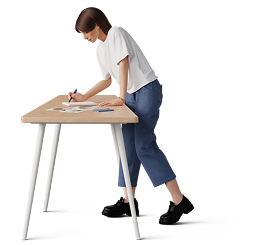
- Design Goals
Based on the insights drawn from user research, I proposed that the solution should be a system that:
- Streamline Equipment Management: Facilitate efficient distribution and oversight of home-office assets across the workforce.
- Enable Real-Time Visibility: Support live updates and monitoring of inventory data for all stakeholders.
- Improve communication: Make it easier for employees, Company managers & CFO, and Hopdesk to stay connected.
- Use feedback for better decisions: Add ways to collect feedback and spot trends.
- Re-framing the Problem
How might we develop a scalable solution that helps facility and operations managers, employees at mid-to-large companies easily manage assets, handle service requests, and optimize surplus inventory – while increasing adoption of Hopdesk’s platform?
Identifying use case
CFO/Employees buys from Hopdesk catalog
Hopdesk receives the order/service request
Hopdesk picks equipment from the partners
CFO/Employees can edit the information
Hopdesk shares the reports & feedback
Hopdesk saves the data and make reports
Employees Feedback
Equipment gets delivered
CFO and employees can track the equipment
CFO/Employees buys from Hopdesk catalog
Hopdesk receives the order/service request
Hopdesk picks equipment from the partners
CFO/Employees can edit the information
Hopdesk saves the data and make reports
Employees Feedback
Equipment gets delivered
CFO and employees can track the equipment
Hopdesk shares the reports & feedback
IDEATION
My next step was to tell a story of how the personas were currently carrying out the tasks.
- Proposed features
With the initial understanding of the problem, I proposed the following features for a minimum viable product .
3
Users MVP
One platform

Hopdesk Admin &
Internal Teams
Hopdesk teams who manage vendor partnerships, service delivery, and client accounts.
- Vendor Management Panel
- Service History Tracker
- Internal Ticketing System
- Feedback Collection & Trends AnalysisCustomer
- Support
- Real-Time Inventory Visibility
- Buying & Spend Tracker
- Product Stock tracker
- Reports generator

CFO/COO (Company Stakeholders)
These are internal decision-makers responsible for employee well-being, budget, and asset logistics.
- Real-Time Inventory Visibility
- Budget & Spend Tracker
- Approval Workflow Integration
- Off-boarding Checklist & Asset Return Tool
- Downloadable Reports for Finance

Employee (Furniture
Recipients)
These are the employees working remotely or in hybrid setups who use the furniture and request services.
- Searchable Product Catalog
- One-Click Order Placement
- Real-Time Delivery Tracking
- Guided Setup & Usage Instructions
- Repair & Replacement Requests
Cross-Platform
Capabilities
1). Real-Time Notifications: Updates for approvals, deliveries, returns, and service status.
2). User-Based Access Control: Limit or allow access based on user type (employee, CFO/COO, Hopdesk)
3). Unique Interface: For on-the-go order tracking and quick service requests.
- Information Architecture
With the features and content in mind, I moved on to structuring the platform to support the three key user groups.
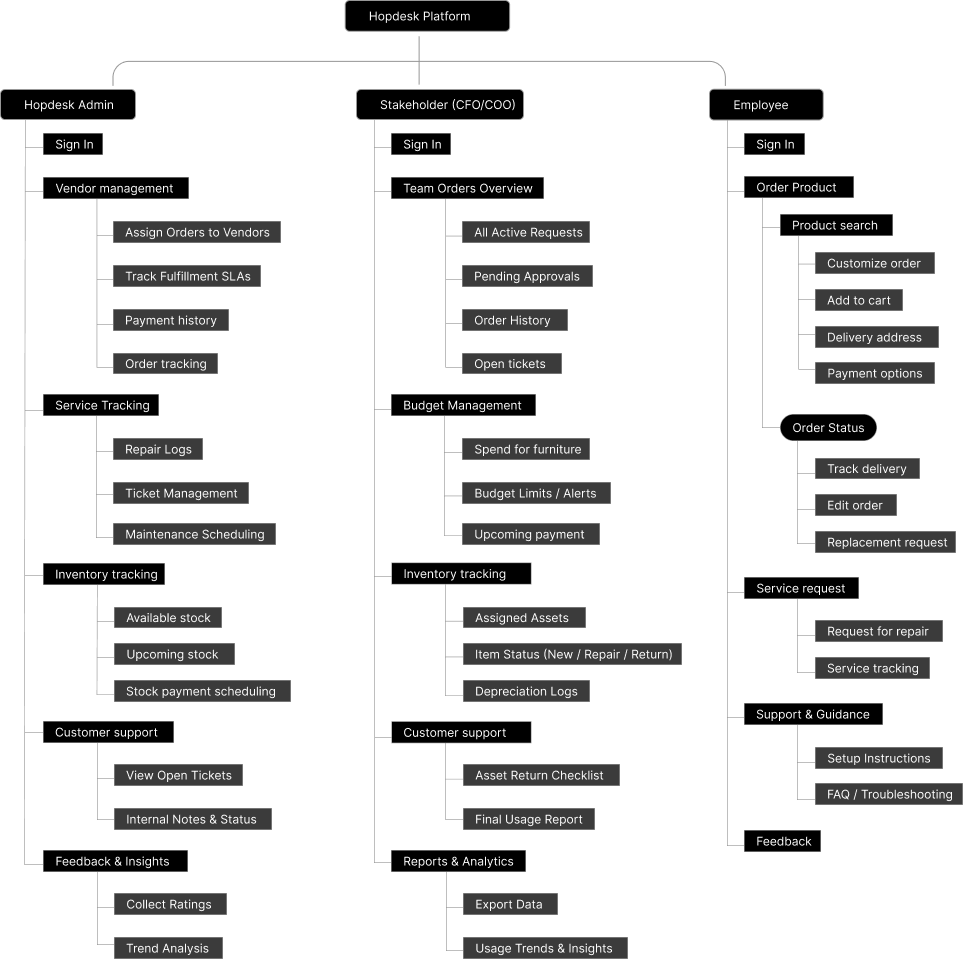
IDEATION
My next step was to tell a story of how the personas were currently carrying out the tasks.
- Proposed features
With the initial understanding of the problem, I proposed the following features for a minimum viable product .
3
Users MVP
One platform

Hopdesk Admin &
Internal Teams
Hopdesk teams who manage vendor partnerships, service delivery, and client accounts.
- Vendor Management Panel
- Service History Tracker
- Internal Ticketing System
- Feedback Collection & Trends AnalysisCustomer
- Support
- Real-Time Inventory Visibility
- Buying & Spend Tracker
- Product Stock tracker
- Reports generator
Cross-Platform
Capabilities
1). Real-Time Notifications: Updates for approvals, deliveries, returns, and service status.
2). User-Based Access Control: Limit or allow access based on user type (employee, CFO/COO, Hopdesk)
3). Unique Interface: For on-the-go order tracking and quick service requests.
3
Users MVP
One platform

CFO/COO (Company Stakeholders)
These are internal decision-makers responsible for employee well-being, budget, and asset logistics.
- Real-Time Inventory Visibility
- Budget & Spend Tracker
- Approval Workflow Integration
- Offboarding Checklist & Asset Return Tool
- Downloadable Reports for Finance
Cross-Platform
Capabilities
1). Real-Time Notifications: Updates for approvals, deliveries, returns, and service status.
2). User-Based Access Control: Limit or allow access based on user type (employee, CFO/COO, Hopdesk)
3). Unique Interface: For on-the-go order tracking and quick service requests.
3
Users MVP
One platform

Employee (Furniture
Recipients)
These are the employees working remotely or in hybrid setups who use the furniture and request services.
- Searchable Product Catalog
- One-Click Order Placement
- Real-Time Delivery Tracking
- Guided Setup & Usage Instructions
- Repair & Replacement Requests
Cross-Platform
Capabilities
1). Real-Time Notifications: Updates for approvals, deliveries, returns, and service status.
2). User-Based Access Control: Limit or allow access based on user type (employee, CFO/COO, Hopdesk)
3). Unique Interface: For on-the-go order tracking and quick service requests.
- Information Architecture
With the features and content in mind, I moved on to structuring the platform to support the three key user groups.
Design
Sketching w/ Pen & Paper
Based on team discussions, I created interface sketches to visualize the user flow across three core experiences:
1). The internal Hopdesk dashboard
2). CFO/COO stakeholder dashboard
3). Employee-facing web interface
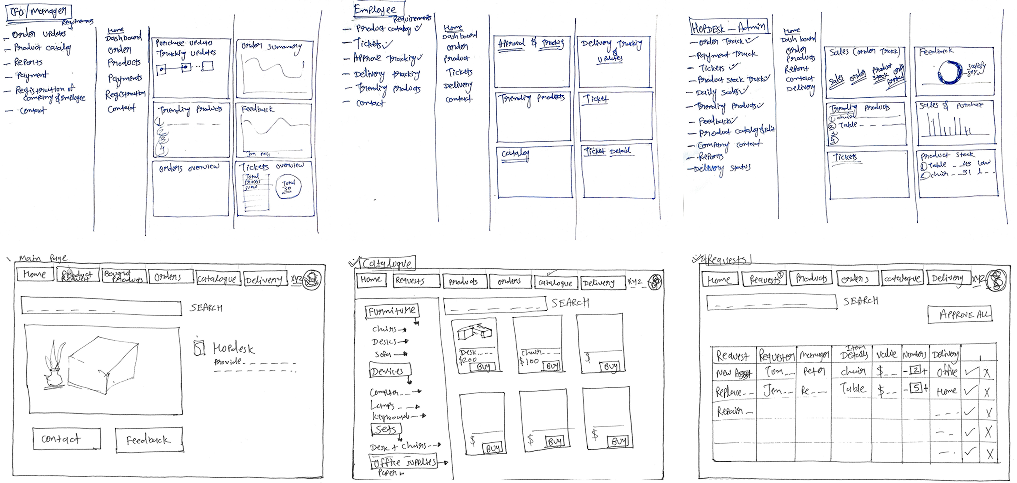
- Annotated Wireframe
Hopdesk Admin - Screen
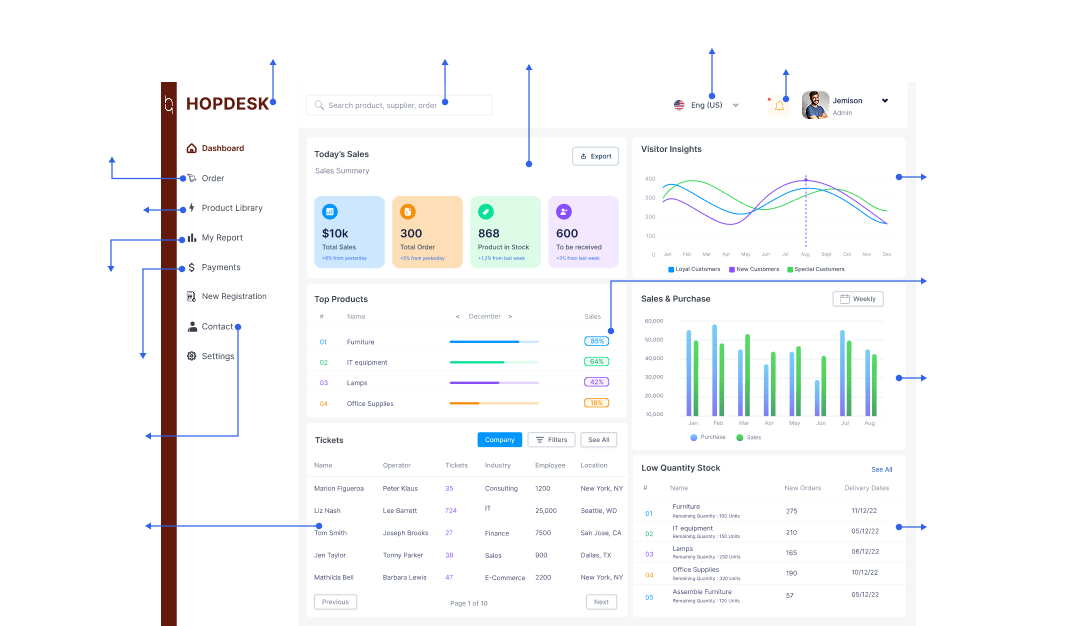
Stakeholder (CFO/COO) - Screen
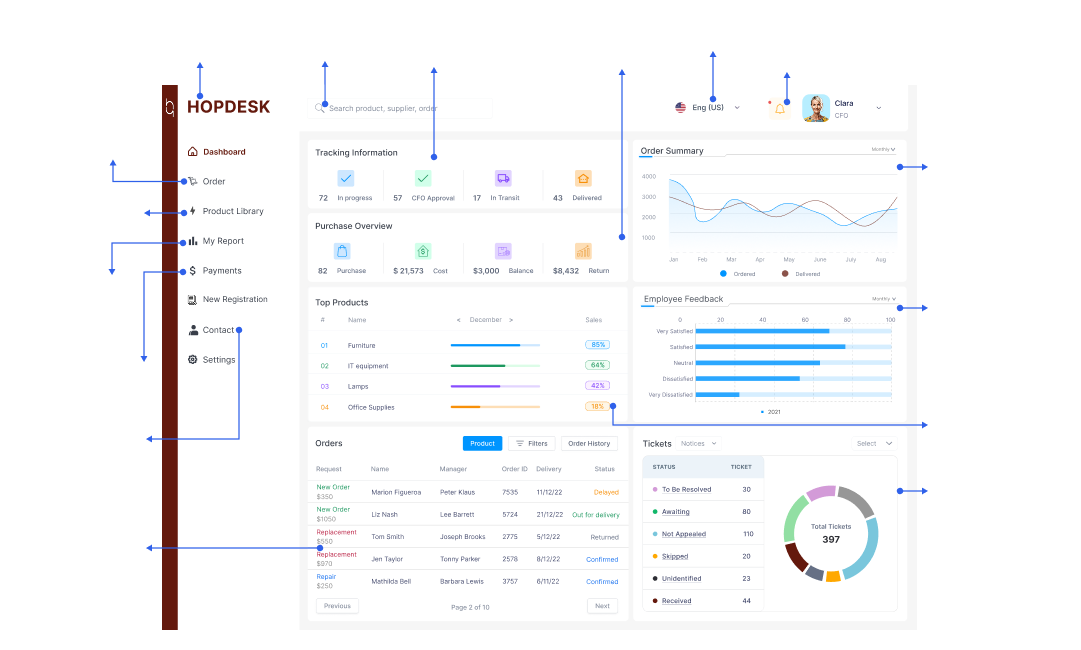
Employee - Screen
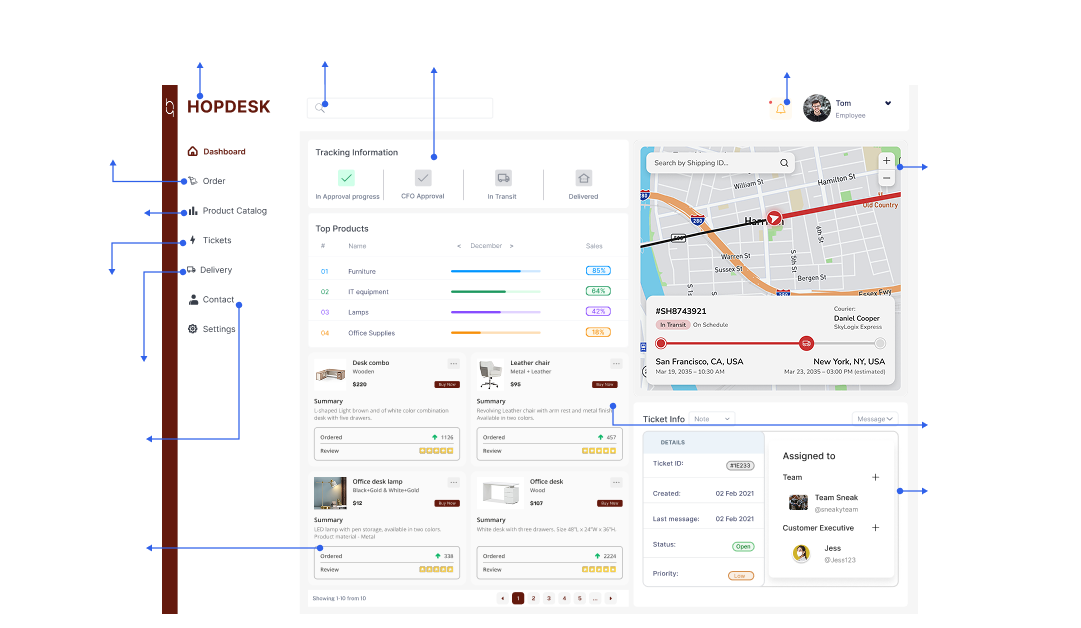
- key takeaway
We designed Hopdesk’s asset management system into an agile, scalable platform – reducing costs, improving visibility, and streamlining logistics with supplier diversification, demand planning, and tailored dashboards. Clients praised its flexibility and efficiency, needing only minor adjustments, unlocking scalability for the hybrid workforce.
I believe in collaboration and open communication, working closely to “Designing experiences where every vision comes alive.”
